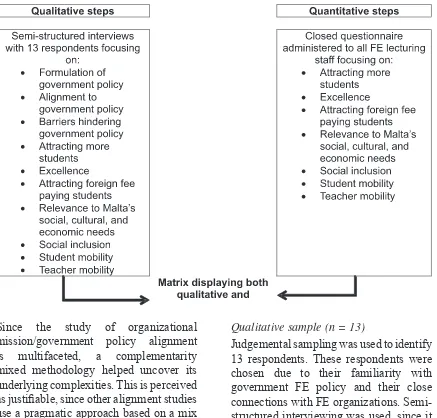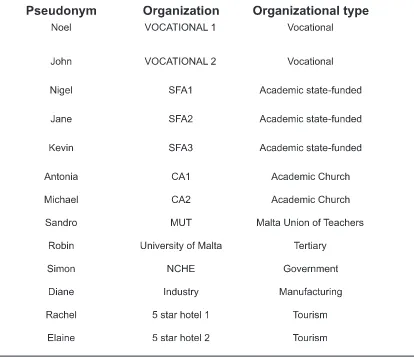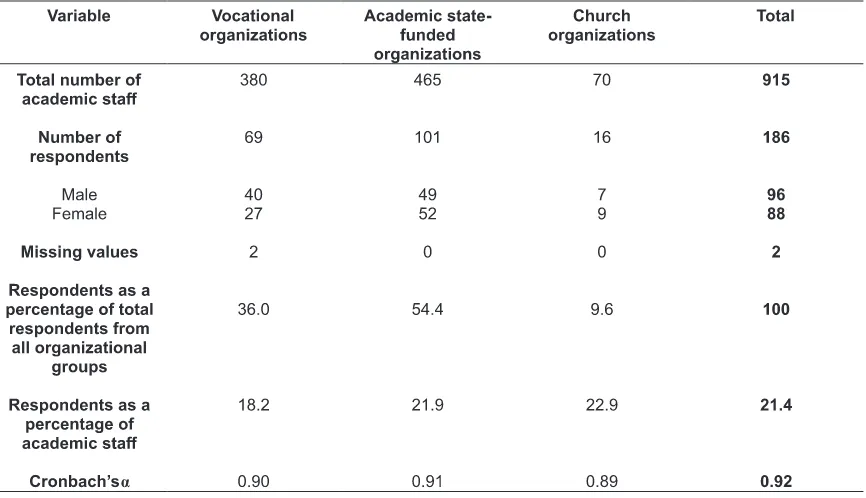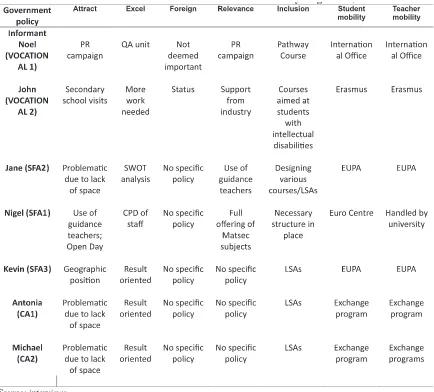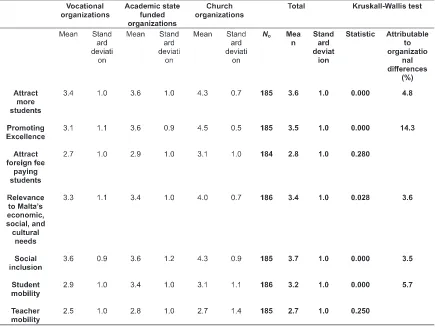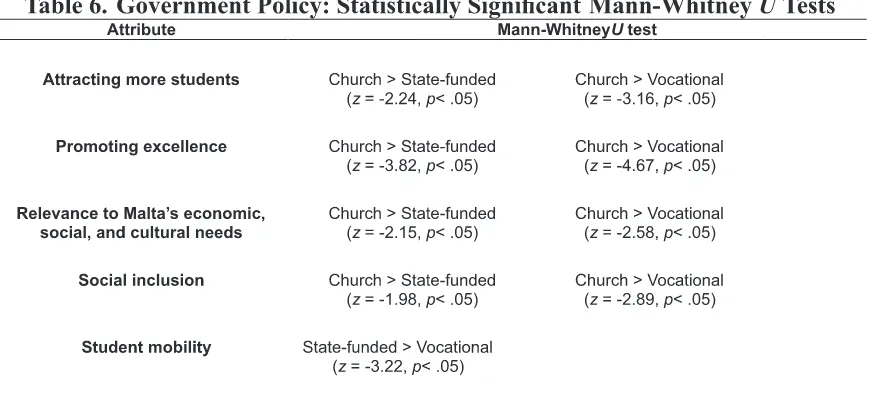2 (1) 1 - 19 ©UB 2013 University of Brawijaya Malang, Indonesia http://apmba.ub.ac.id
Chinese Whispers? The Congruence Between Maltese
FE Organizations’ Missions and Government Policy
For the Sector
Nicholas Zarb
Junior College, University of Malta
Abstract
This paper delineates the assessed alignment between the Maltese government’s policy for the further education sector (FE) and FE organizations’ missions. Since alignment is multifaceted, a complementarity blended approach was used to help uncover its complexities. Data were collected from seven FE vocational and academic organizations via questionnaires to academic staff; interviews with principals and other internal and external stakeholders; content analysis of mission statements. Data showed that there is only moderate alignment between organizational mission and government policy with large vocational organizations displaying more alignment with such policies.The use of a complementarity blended method may be useful to explain educational alignment in other small states. Short bureaucratic distances are not a guarantee of alignment.
Keywords
further education; mixed method; small island states; Malta Received: 29 May 2013; Accepted: 5 August 2013 ; Published Online: 30 August 2013
Introductıon
This paper seeks to illustrate the alignment that exists between government policy and further education (FE) organizations’ missions. Malta currently lacks an appropriately skilled workforce both nationally and internationally (National Commission for Higher Education [NCHE], 2009). Part of the reason for this is that a high number of FE students fail to complete their education at both academic and vocational post-secondary level. Improved retention and completion with the right knowledge and skills are
important government policies for this sector and it is imperative to see whether government policy on this is recognized and implemented in FE organizational policies. This work commences with the background to the study, a literature review focusing on stakeholder and policy theory, research questions, methodology, results and conclusion.
Background to the Study
mission alignment has an external focus, for example, between the organization and external stakeholders (Berg, Csikszentmihalyi, and Nakamura, 2003). In the USA and Canada, FE colleges have aligned their mission to mirror local government policy, secondary education, and workforce needs (Good and Kochan, 2008; Levin, 1999). These considerations of mission alignment mean that a policy-practice gap may be present between governmental policies and strategies on one side and organizational mission/ strategies on the other (Honig and Hatch, 2004). Given a dynamic environment, mission alignment may involve a continual negotiation between different parties in order to bridge policy gaps. Studies have also shown that teachers may lack knowledge and understanding of government policy in further education (Akinyemi, 1987). Moreover teacher training has been criticized for its learner-centeredness and its lack of alignment with government policy since faculty professors and policy-makers may have different agendas (Stone, 2001). This may be helpfully lessened by the provision of information and evolving a positive mind-set (van Riel, 2012).
FE sectors in different countries may vary. In the UK, FE organizations offer courses on a full- or part-time basis to students aged 14 and over, while in Malta, Australia and the USA courses are offered to 16+ students. Furthermore the research emphasis in the UK and Australia is on VET organizations while in the USA such emphasis is on community colleges (Boggs, 2007). All three countries are alike in terms of rationale, e.g. the VET sector has ‘its roles of an industry skills trainer, the major adult education provider, a post-school education provider and a provider to school age students’ (Keating, 2006:68), while community colleges
are perceived as drivers of economic growth in rural areas (Rephann, 2007) by serving five curricular purposes: academic transfer preparation, vocational-technical education, developmental education, continuing education, and community service (Warren, 2006).
In this work the Maltese post-secondary educational sector (excluding university) will be referred to as the FE sector, following the definition stated by the National Commission of Higher Education (NCHE) whereby FE is defined as ‘all formal education of persons above the compulsory school age, leading to qualifications classified at NQF [National Qualifications Level] levels 1 to 5’ (NCHE, 2009:11). Most FE organizations are academic in nature (seven out of nine [77%]). Since the early 1990’s there have been significant shifts in the Maltese educational system, with the FE sector in particular, being deemed necessary in the light of the country’s continual economic and industrial expansion in both manufacturing and service industries. This expansion has resulted in a more complex FE system which may justify more effort on the part of stakeholders to ensure that alignment ensues. As a result, the number and range of FE organizations started increasing and diversifying in the 1990s (Xerri, 1990). This was driven by policies which encouraged post-secondary education, an example being more flexibility for students who wished to switch from one FE organization to another, and for students to enter University via vocational organizations, rather than the more traditional sixth forms (Education Department, 1988). Maltese government policy for the FE sector is partly dictated by the EU. Since EU policy regulations impinge on FE organizations through the government,
‘government policy’ refers to both local initiatives as well as any EU regulations for the FE sector. Such local government policy was outlined in an NCHE publication titled ‘Further and Higher Education Strategy, 2020’ (NCHE, 2009). The above scenarios prompted the author to examine the link between government policy for the FE sector and FE organizations’ missions. To date, very little work has been done in this field and none in Malta. This work will partly fill this knowledge gap, based on the following research question: how do FE organizations’ missions compare with statutory and advisory government policy for the sector? To help answer this research question, the literature review concentrates on how stakeholders partake in government policy crafting.
Lıterature Revıew Stakeholder theory
Stakeholder theory was put forward by Freeman (1984) as a suggestion for the strategic management of organizations. Over time, this theory has increased in standing, with significant works by Clarkson (1995), Mitchell et al. (1997), and
Rowley (1997), permitting both greater theoretical depth and development. From a primarily strategic viewpoint, the theory progressed and was espoused as a means of management by many market-based organizations (Mitchell et al., 1997) with
its movement into educational studies as market orientation grew from the 1980s. There are two main reasons for considering the inclusion of stakeholder view in this research. First, organizational success is not simply a matter of increasing wealth since other criteria, such as disclosure of strategic direction and internal processes to both internal and external stakeholders, have a positive effect on how the organization
is perceived (Kaplan and Norton, 2006). Secondly, for alignment between organizational mission and government policy to be present, organizations might have to meet or exceed stakeholders’ expectations (Duffy, 2004). It has been argued that organizational alignment will ensue when stakeholder perspectives are aligned leading to organizational goal achievement (Fleming, 2012). To achieve this, open communication based on trust is perceived as imperative (Caldwell, 2008) and may lead to stakeholder alignment – a state where all relevant educational stakeholders are involved in problem-solving (Ortiz, 2008). This may safeguard the long-term feasibility of organizations and policies (Bryson, 2004).Yet, empirical evidence from the HE sector in the USA demonstrates that such alignment based on shared vision may be unfeasible (Barnett, 2011). It may be better to ‘embrace the multiplicity of meanings inherent to change and strive to conjoin divergent perspectives’ (ibid.:139) rather than ‘try
to convince them to change their minds’ (Duffy, 2004:181).
Government policy
described in terms of what a government does not do (Newton and van Deth, 2005), while a more economic approach views policy as the action a government follows to advance a society’s wellbeing, given limited resources (Alcock, 2003).
Inasmuch as it works within a complex social environment, policy may be important since it is one of society’s shapers and is considered influential (Woolhouse and Cochrane, 2009). Thus public policy in one area usually impacts other areas (Taylor et al., 1997). For
example, the abolition of unemployment benefits in Australia aimed at 16 – 17 year-olds in the 1980s had the effect of raising the school leaving age (ibid.),
whilst the introduction of an educational quasi-market in the same period in the UK resulted in greater inequality, since bright students from poorer backgrounds suffered (Machin and Vignoles, 2006). In light of these examples FE policy should be linked to other policy areas (e.g. economic development), thus providing consistency (Maclean and Pavlova, 2010). To implement the above, such polices have led to a managerialist approach based on accountability, standards, testing, diversification of revenue sources, the implementation of cost-recovery policies, and privatization (Huang, 2012) all of which may maintain alignment (Duffy, 2004). In many cases, the rationale for such policies has been market efficiency with the introduction of incorporation in the FE sector in many countries (Mather
et al., 2007). This was done to increase
parental choice, based on information such as school league tables, and to help FE organizations focus on utilitarianism (Dalley-Trim et al., 2008). Such
utilitarianism is discursively expressed in terms of skills, qualifications, mobility, and knowledge, attributes all seemingly
important in the modern, globalized knowledge-based economy, grounded in a flexible workforce (Nairn and Higgins, 2011).
This manifests itself in the numerous neoliberal educational policies advocated by these institutions (Mitchell, 2006). In the EU this is subject to the principle of subsidiarity with individual states partaking in decision-making (Johnson, 2003). The Lisbon Agenda and the Bologna Process (signed in 1998 and 2002 respectively) tabled a common framework of qualifications including the European Credit Transfer System (ECTS) and curricula styled on learning outcomes (European Union, 2010). Learning outcomes are defined as ‘statements of what a learner knows, understands and is able to do on completion of a learning process’ (Azevedoet al., 2012). The
Copenhagen Declaration continued the neoliberal dialogue with the introduction of transparency and the Europass. The latter is a document similar to a CV indicating the work history and qualifications of vocational workers (Ertl, 2006). The Bologna and Copenhagen processes reflect a model that is eclectic, borrowing from different aspects of VET policy from ‘highly influential countries’ (Powell et al., 2012:255) including the
USA, UK and Germany. These policies indicate that Maltese FE policies are partly dictated by EU as well as local needs based on the acquisition of skills, knowledge, competences, and qualifications and located within a curriculum (Barslund, 2012). Yet small states such as Malta may ‘identify and prioritize more pressing national objectives’ than those of their European counterparts (Crossley et al.,
Therefore despite the effect(s) of globalization, policies are subject to local contexts and realities (Huang, 2012) resulting in ambiguous and conflicting messages (Tan, 2008). Furthermore, small states have limited financial and human resources, meaning that the linkage between utilitarian educational courses and industry may be vital, a lack of which may lead to the social rejection of the course since it may take a long time for fresh graduates to find a job, as in the case of St Kitts and Nevis (Crossley
et al., 2011). The problem is magnified
since small states have a limited industrial base, which may lead to complications of scale factors (Farrugia, 2002) and the marginalization of humanistic education (Kent, 2012).
Policies are only effective if implemented well. Policy implementation is a process that should have some desirable and Within the educational context, policy implementation may be defined as a process of ‘transforming educational policy into practice’ (Hope, 2002:40). Governments’ F.E. policy implementation varies. For example, USA federal intervention has been perceived to increase since the 1960s and now includes curriculum, pedagogy and results’ benchmarking (Spillane, 2008). Such intervention is deemed necessary to align high-schools’ output, workplace needs, and university places (Achieve, 2008) but variations occur as policy application is left to individual states (Akiba et al.,
2007). Similarly, the UK’s four states may interpret national policies differently (McTavish, 2006). There seems congruent
acceptance, however, across all four, of national FE policy including parents and central inspectors as stakeholders (Lumby, 2007).
Those EU countries which traditionally stressed FE in their educational set-up are now challenged to change, meaning that contextual issues may have to be taken into account during implementation (Balzer and Rusconi, 2007). Implementation procedures range from a single element (e.g. legislation) to whole-scale educational transformations (Maclean and Pavlova, 2010). In Norway the implementation of quality reform in FE and HE may be perceived as an example of a single-element transformation (Dunkel, 2008). Alternatively, reform in the Danish FE sector was perceived to be much more comprehensive impacting on various elements, such as policy formulation, funding, quality standards, and feedback mechanisms (OECD, 2008). Locally the setting up of the Malta Qualifications Council is perceived as a direct result of the Bologna Process (Gatt, 2009). Furthermore, HE and the VET component of FE may compete for students, funding, and status as is happening in Germany, France, and Holland leading to the hybridization of organizations: VET organizations which offer bachelor degree courses (e.g. VOCATIONAL 1 in Malta) and universities which offer vocationalized courses (Dunkel, 2009).
Methodology
The above considerations outlined in the literature review have led the author to ask the following research question:
How do FE organizations’ missions compare with statutory and advisory government policy for the sector?
quantitative analyticapproach focused on the perception of government policy alignment by a number of important stakeholders (members of the FE organizations’ management team, government officials, Union officials, business and tourism representatives, and FE lecturers). In thefollowing text, the qualitative and quantitative samples are delineated together with data collection and measures, and analytic approach. The full set of analytic steps involving both qualitative and quantitative methods is presented in Figure 1.
(Aversanoet al., 2009). One type of question
may be insufficient to uncover all aspects relating to alignment, making necessary a mixed approach. This might help uncover both causal relationships (quantitative) and explanations (qualitative). Therefore, complementarity helps ‘in building stronger conclusions’ (Bazaley and Kemp, 2011:56), and enhances completion and detail. Complementarity is therefore akin to creating a mosaic, with a definite pattern composed from qualitative and quantitative data (ibid.).
Figure 1. Qualitative and Quantitative Methodological Steps
Since the study of organizational mission/government policy alignment is multifaceted, a complementarity mixed methodology helped uncover its underlying complexities. This is perceived as justifiable, since other alignment studies use a pragmatic approach based on a mix of positivist and interpretative methods
Qualitative sample (n = 13)
be free in their questions and responses within the limits of topics which were identified beforehand. Interviews lasted approximately 60 to 120 minutes and were digitally recorded. All participants agreed to the interview after being formally invited in writing. Transcripts were written in grammatically correct English to lessen informant distress (Kvale, 1996), and informants were given the option to answer
in English or Maltese. In all cases anonymity was achieved by using pseudonyms (Table 1).
Contingencies forced certain changes to the above plan. Permission to administer the questionnaire to academic staff at
VOCATIONAL 2 was not granted with no explanation given. To partly mitigate the effects of the above, the researcher decided to interview two senior managers from two five star hotels. These particular hotels are known for their strong links with VOCATIONAL 2. Such an approach led to the triangulation of these two respondents’ answers.
Quantitative sample (n = 915)
Since the number of teaching staff in different FE organizations is strikingly different, all teaching/academic staff were included in the sample. Sampling techniques were excluded since this would have led to a very small sample from certain FE organizations (Table 2). When
grouped according to organizational type, the lowest percentage of respondents was from vocational organizations (18.2%) and the highest was from Church FE organizations (22.9%). In total 51.6% of respondents were male (no = 96) and 47.3% were female (no = 88) with 1% declining to respond. A Kruskall-Wallis test1
demonstrated no significant differences among the organizations (Asymp. Sig. = 0.095; p< .05).
investigates, and states patterns or themes within data (Braun and Clarke, 2006). The impact of certain features of small nation states (e.g., vulnerability and adaptability) and the focus on localized narratives were factorized into respondents’ answers (Alebaikan and Troudi, 2010).
One problem associated with qualitative data in generalizability and its absence would indicate that such work would have
The seven closed statements in the questionnaire were to gauge the following attributes: government policy for the FE sector: attract more students, achieving excellence, attract foreign fee-paying students, relevance to Malta’s economic, social and cultural needs, social inclusion, student mobility, and teacher mobility.
Qualitative data analysis
Thematic content analysis was used to analyse the semi-structured interviews.
Thematic analysis ‘is a process for encoding qualitative information’ (Boyatzis, 1998: vi) and recognizes,
lesser value (Horsburgh, 2003). In this work analytic generalizability was utilized (Yin, 2011). Generalizabilityrefers to the skill of extending the validity of a study’s conclusions to other cases of the same kind (Robson, 2004), suggesting that researchers should generalize results to theory, similar to the way a natural scientist generalizes from experimental results to theory (Yin, 2003). Therefore, ‘the goal [of analytic generalization] is to pose the propositions and hypotheses at a conceptual level higher than that of the specific findings’ (Yin, 2011:101).
Quantitative data analysis
The close-ended statements in the questionnaire were analysed using SPSS® software (Version 16). Data for every organization was analysed individually. The Microsoft Excel® package was not used owing to reported inaccuracies when processing data for inferential statistics (McCullough and Heiser, 2008). Notes were taken to ensure that errors were avoided. Data for every organization was analysed individually. The analysis consisted of checking whether the data for each attribute followed a Gaussian distribution (important in establishing the choice of inferential statistical tests), crosstabs between the different attributes, and demographic data (e.g. student learning against length of time teaching in the organization). Data sets for different organizational alignment (Labovitz and Rosansky, 1997).
Results
Qualitative data results
A summary of informants’ responses is delineated in Tables 3 and 4respectively. All interview informants within FE organizations in this work, apart from Kevin, were highly critical regarding their role in crafting FE government policy, as spelt out in NCHE’s Strategy 2020 document. Noel stated, “We were consulted towards the end of the process. We would very much have liked to get involved at an earlier stage. That was
unfortunate because VOCATIONAL 1 had a lot to offer.”CA1 and CA2 were only
slightly involved in the process. Michael, elaborated, “I was not really personally
involved in this. We had meetings with
the NCHE and we offered our feedback.
However, we haven’t met for a long time now. Discussions seemed to have stopped. Our suggestions were not taken up. We talked about the problems with recruiting
staff, but nothing ever happened.” This lack of involvement was echoed by Nigel who, at the date of the interview, was still unaware whether suggestions he passed on were taken up, and Jane who was invited to attend meetings but had no say. Lack of consultation was an important issue for Sandro, “By and by, rather than saying that we have been excluded from policy insights, it seems that we have been side-lined and forgotten. This at times happens through the dissolving of certain
committees. Our absence is not good.”
Yet, when interviewed, Simon maintained that there was a full consultative process including all stakeholders (students, unions, VOCATIONAL 1, government, opposition spokesperson for education, and university), and that it was a “lengthy
process”, and included a presentation to all concerned. At the same time Simon stated,
“I remember working on this with the previous CEO (while I was still Chairman).
We concluded it overnight after a period of time (months), dedicated to consultation
with external stakeholders”. The only FE interview informant in accordance with Simon was Kevin, who stated, “They
(NCHE officials) came here to interview staff. I went (to Malta) various times and contributed”.
policy was not derived from government but from the organization’s strategic plan. At SFA1, CA1, and CA2 informants indicated that government did very little to ensure that policies were followed. Nigel added that any policies must be coupled with funds.
been neglected, and that they were in the dark about what might happen in the future. Kevin felt that government had ‘abandoned’ FE, while Michael stated, “It
seems that education stops at 16, leaving
us in a void.” This seemed to be confirmed by Simon, who stated, “Unfortunately the focus has been on reforming compulsory schooling, which does not mean that FE has been given secondary importance, but reforming compulsory education is a tall
order.”
Informants were also critical of the Matsec regime. One of the weaknesses
perceived by Kevin was the lack of time to complete the Matsec syllabus, especially in the second year. Simon was also quick to point out that this inflexibility is counterproductive, since it inhibits creativity. Robin elaborated on this inflexibility stating that it was a win-lose situation, and wondered whether additional competences and skills may be graded. He stated, “These students interacted with other students, some of whom had the same subject. Even if the student didn’t want to, he would have learnt more than he presents in his exams.
Quantitative data results
Table 5 displays the average values for policy alignment for each organizational group, that is, vocational, academic state-funded, and Church. Church organizations were given the highest rating followed by academic state-funded and vocational organizations. One would hypothesize that respondents would give higher ratings to the link between government policy and organizational mission in those organizations where procedures were in place to ensure this happened (e.g. vocational organizations) and in organizations whose mission statement mention government policy. The opposite is true. Church organizations had no or very few procedures, yet respondent ratings were highestTable 6 displays the
statistically significant Mann-Whitney
U tests. These tests are somewhat
economic aspect. The small size and the more controlled environment found in Church FE organizations may have contributed to significantly higher ranking for ‘social inclusion’. On the other hand, given that vocational organizations have a wider variety of schemes whereby students may continue their studies abroad did not result in significantly higher ratings for ‘student mobility’ thus displaying some measure of incongruence.
Figure 2 displays radar diagrams for organizational groups and the whole FE system. The ratings for Church FE organizations were higher than state-funded academic and vocational organizations. Teacher and student mobility got very low ratings, thus displaying the least alignment with government policy. This could be due to the rigidity of the Maltese FE system as outlined by many interview respondents. This rigidity is particularly seen in Matsec with many informants displaying their frustration with the system.
Integrating the different data sets
Figure 3 delineates the alignment present between organizational mission and government policy for the Maltese FE sector. FE organizations are placed along
a scale from ‘more alignment’ to ‘less alignment’. In terms of social systems theory, more alignment acts to lower the
entropy of the system, since it increases order. Conversely, less alignment tends to increase the entropy of the system,
since it decreases order. The total 3.3 was calculated by averaging the values for the various policy attributes, that is, attract more students, relevance to Malta’s economic, cultural and social needs, enhancing social inclusion, attracting foreign fee-paying students, promoting excellence, student mobility, and teacher mobility.
Dıscussıon
policy making. Even though government policies seem to be somewhat centralized, as one would expect in a small state, their implementation is piecemeal, rather than comprehensive (Dunkel, 2008).
This lack of comprehensiveness may be examined from a strategic viewpoint. It seems that the Maltese government is more interested in planning rather than strategic considerations. Planning consists of looking backward to see what an organization wants to achieve. It is based on the concept ‘more of the same’ and is thus incremental in nature. Real strategic planning, on the contrary, leads to quantum leaps and is based on creative and innovative thinking processes leadingto scenario building (Mintzberg, 1994).
Another danger lies in the apparent link between the abovementioned policy attributes and neoliberal thought. For example, the policy attribute ‘relevance to Malta’s economic, social and cultural needs’restricts the attention of FE organizations to their economic utility and restrains societal opportunities and the communities in which people live. Such constraints influence the social context that buttresses curriculum development and educational debate. With the above in mind, one should be thoughtful before adopting any policies which apparently follow ‘common sense’ logic, but are in fact designed for a better performing economy.
Furthermore, the focus on compulsory education seemed to be the line taken by government, and is likely to be congruent with the political agenda of the party in power (Yeatman, 1990). However, such political agendas might be populist rather than aiming to achieve real educational change. Furthermore, the various government policy attributes do
not seem to be linked to one another, or to the realities faced by most Maltese FE organizations. Thus policy consistency, as outlined by Malcom and Pavlova (2010), appears to be absent. This lack of consistency may be linked to the lack of a fully developed neoliberal culture. In this paper only VOCATIONAL 1 and VOCATIONAL 2 seemed to have a managerialist regime. This, however, has to be tempered by the lack of incorporation in the Maltese FE sector. The managerialist regimes as espoused by Huang (2012) and Mather et al. (2007) seemed to be
absent. Nonetheless, the assertion that such a managerial climate is essential for mission alignment (Duffy, 2004), may be unwarranted. The data illustrates that the smaller FE organizations, which are far removed from a managerialist set-up, are more aligned with government policy.
Conclusıon
Results indicated poor to medium alignment between organizational mission and government policy, probably due to the lack of direct participation by many stakeholders some of whom were at a loss to explain the current situation. There was also the possibility that FE organizations’ informants were reactive (rather than proactive) in their responses and did the least possible to accommodate government policies as outlined by the NCHE. This was exemplified by Antonia’s assertion, “At the moment I feel that we are in limbo.” Furthermore, Antonia believed that the government did not provide “any
help whatsoever.”
Likewise, Michael was highly critical of government policy. Like Antonia, he perceived that sixth form “is being left
led Michael to “look inward into my
organization rather than look out.”
There seems to be a lack of trust between government and FE stakeholders. This may be helpfully lessened by regular talks among stakeholders on a national level.
Vocational organizations are more likely to be aligned with NCHE’s policy directives, the exception being excellence (Church organizations rated higher in this respect). If excellence may be used as a measure of student learning, this may mean that some policy directives might not have a direct impact on student learning. Furthermore, it is clear that some directives (e.g. attract more students), might not be followed owing to organizational priorities and contingencies.The results of this work also have implications for small states in general. The short bureaucratic distance between government and FE organizations is not a guarantee that such organizations are fully aligned with government policies. While acknowledging that policy implementation seems to be as confusing as policy theory, the author subscribes to an optimistic outlook suggesting that an ever larger body of knowledge may ‘guide practice in informed, responsible and productive ways’ (Honig, 2006:22). One may rightly argue that the above work represents insights rather than expedient formulas due to the complexity and contingency of the implementation process.
Notes on Contributor
Nicholas Zarb is Senior Lecturer at the Junior College. Because his work involves a certain amount of research, reading has become one of my major interests. His range of reading includes philosophy, history, artistic expression as well as scientific and technological advances. He is also a keen classical and flamenco guitarist. He has performed to local as well as foreign audiences (Italy, Germany, Thailand and Japan). He enjoys traveling independently and for this reason, he traveled widely in Europe and Asia.
References
AchieveInc. (2008). Making College and Career Readiness the Mission for
High Schools.Washington: Achieve
Inc.
Akiba, M., LeTrende, G. K., & Scribner, J. P. (2007).Teacher Quality, Opportunity Gap, and National Achievement in 46 Countries.
Educational Researcher, 36(7),
369–387.
Akinyemi, K. (1987). Aligning Practice with Policy in Vocational-technical Education.Vocational Aspect of Education,
39(102), 15–18.
Alebaikan, R., & Salah Troudi, S. (2010). Online Discussion in Blended Courses at Saudi Universities. Procedia Social and Behavioral Science, 2(2), 507–514.
Aversano, L., Grasso, C., &Tortorella, M. (2009). A Framework for Measuring the Alignment between Business Processes and Software Systems.
Communications in Computer and
Information Science, 59(1), 213– 220.
Azevedo, A., Apfelthaler, G., & Hurst, D. (2012). Competency Development in Business Graduates: An Industry-driven Approach for Examining the Alignment of Undergraduate Business Education with Industry Requirements. The International Journal of Management Education,
10(1), 12–28. Arenas of Educational Governance. K. Martens, A. Rusconi& K. Leuze, Basingstoke, Palgrave.
Barslund, M. (2012).Recent Developments in Selected Education Indicators and Their Relation to Europe 2020 Targets.National Institute Economic
Review, 220(4), 6–18.
Bazaley, P., & Kemp, L. (2011). Mosaics, Triangles and DNA: Metaphors for Integrated Analysis in Mixed Methods.Journal of Mixed Methods
Research, 6(1), 55–72.
Bell, L., & Stevenson, H. (2006).
Education Policy: Process, Themes
and Impact. London: Routledge.
Berg, A., Csikszentmihalyi, M., & Nakamura, J. (2003). Mission
Possible: Enabling Good Work in Higher Education. Change, 35(5), 40–47.
Boggs, G. (2007). Lessons in Leadership: Will Community Colleges Save the Day? Community College Journal, 31(8), 14–17.
Bonal, X. (2004). Is the World Bank Education Policy Adequate for Fighting Poverty? Some Evidence from Latin America.International
Journal of Educational Development, 24(6), 649–666.
Boyatzis, R. E. (1998). Thematic Analysis and Code Development:
Transforming Qualitative
Information. Thousand Oaks: Sage. Braun, V., & Clarke, V. (2006).Using
Thematic Analysis in Psychology. Qualitative Research in Psychology, 3(2), 77–101.
Bryson, J. M. (2004). What to Do When Stakeholders Matter. Public
Management Review, 6(1), 21–53. Caldwell, B. J. (2008). A New Framework for
Understanding How Transformation Occurs in Schools.The International
Congress for School Effectiveness and Improvement, Auckland, New Zealand.
Clarkson, M. B. E. (1995). A Stakeholder Framework for Analyzing and Evaluating Corporate Social
Performance.Academy of
Management Review, 20(1), 92−117. Crossley, M., Bray, M., & Packer, S.
(2011). Education in Small States: Policies and Priorities. Hampshire:
Commonwealth Secretariat.
Australian Educational Researcher,
35(2), 55–69.
Duffy, F. M. (2004). Moving Upward
Together: Creating Strategic Alignment to Sustain Systemic
School Improvement. USA: Scarecrow Education.
Dunkel, T. (2009).The Bologna Process between Structural Convergence and Institutional Diversity.European Journal of Vocational Training,
46(1), 174–196.
EducationDepartment. (1988). Development of Education, 1986–1988. The 41th Session of the International Conference on Education,Geneva.
Farrugia, C. J. (2002). Rewards and Tribulations of Senior Education Managers in Small States.Education Planning and Management in Small States: Concepts and Experiences. G. Baldacchino& C. J. Farrugia. Essex, Commonwealth Secretariat. Fleming, J. (2012). Partnerships and
Relationships in Cooperative Education: Are Stakeholder Perspectives Aligned?Acen National
Conference.
Freeman, R. E. (1984). Strategic
Management: A Stakeholder
Approach. Boston: Pitman.
Gatt, S. (2009). The Impact of the Bologna
Process on Higher Education
Institutions in Malta. Brussels: UEPA.
Hantrais, L. (2003). Social Policy and the European Union.The Student’s Companion to Social Policy.P. Alcock, A. Erskine & M. May. Cornwall, Blackwell.
Hogwood, B. W., & Gunn, L. A. (1984).
Policy Analysis for the Real World.
Great Britain: Oxford University Press.
Honig, M. (2006). Complexity and Policy Implementation: Challenges and Opportunities for the Field. New Directions in Education Policy Implementation: Confronting Complexity. M. Honig. USA: State University of New York Press. Honig, M., & Hatch, T. C. (2004). How
Schools Strategically Manage Multiple, External Demands.
Educational Researcher, 33(8), 16–
30.
Hope, W. C. (2002). Implementing Educational Policy: Some Considerations for Principals.The Clearing House, 76(1), 40–43. Horsburgh, D. (2003). Evaluation of
Qualitative Research.Journal of Clinical Nursing, 12(2), 307–312.
Howlett, M., & Ramesh, M. (2003).Public Policy, Policy Cycles and Policy Subsystems (2 ed.). Oxford: Oxford
University Press.
Huang, T. (2012). Agents’ Social Imagination: The ‘Invisible’ Hand of Neoliberalism in Taiwan’s Curriculum Reform. International
Journal of Educational Development, 32(1), 39–45.
Johnson, N. (2003). State Welfare.The Student’s Companion to Public Policy.P. Alcock, A. Erskine & M. May. Cornwall, Blackwell.
Kaplan, R. S., & Norton, D. P. (2006).
Alignment: Using the Balanced Scorecard to Create Corporate Synergies. USA: Harvard Business
School Press.
Good, J. M., &Kochan, F. (2008). Creating a Quality Program by Linking Strategic Planning and Assessment through Collaboration.The annual meeting of the American Association of Colleges for Teacher Education, Hilton New Orleans Riverside, New Orleans.
Keating, J. (2006). Post-school Articulation in Australia: A Case of Unresolved Tensions. Journal of Further and Higher Education, 30(1), 59–74.
Kvale, S. (1996).Interviews: An Introduction to Qualitative Research Interviewing. London: Sage.
Labovitz, G., & Rosansky, V. (1997).The Power of Alignment: How Great Companies Stay Centered and Accomplish Extraordinary Things.
USA: John Wiley and Sons.
Levin, J. S. (1999). Missions and Structures: Bringing Clarity to Perceptions about Globalization and Higher Education in Canada. Higher Education, 37(1), 377–399.
Lumby, J. (2007). Parent Voice: Knowledge, Values and Viewpoint.
Improving Schools, 10(3), 220–232. Machin, S., &Vignoles, A. (2006).
Education Policy in the UK.
London: Centre for the Economics of Education.
Maclean, R., &Pavlova, M. (2010). Planning and policy development for technical vocational education and training systems.International Encyclopedia of Education. P. Peterson, E. Baker & B. McGaw. Oxford, Elsevier.
Mather, K., Worrall, L., & Seifert, R. (2007).Reforming Further Education: The Changing Labour Process for College Lecturers.
Personnel Review, 36(1), 109–127.
McCullough, B. D., &Heiser, D. A. (2008). On the Accuracy of Statistical Procedures in Microsoft Excel 2007. Computational Statistics and Data Analysis, 52(10), 4570–4578.
McTavish, D. (2006). Further Education Management Strategy and Policy: Institutional and Public Management
Dimensions. Educational
Management Administration and Leadership, 34(3), 411–428.
Mintzberg, H. (1994). The Rise and Fall of Strategic Planning. New York:
Prentice Hall.
Mitchell, R. K., Agle, B. R., & Wood, D. J. (1997). Toward a theory of Stakeholder Identification and Salience: Defining the Principle of Who and What Really Counts.
Academy of Management Review,
22(4), 853−886.
Nairn, K., & Higgins, J. (2011). The Emotional Geographies of Neoliberal School Reforms: Spaces of Refuge and Containment. Emotion, Space and Society, 4(3), 180–186.
NCHE.(2009). Further and Higher Education Strategy 2020. Valletta:
National Commission for Higher Education.
Newton, K., & van Deth, J. W. (2005).
Comparative Politics. Cambridge:
Cambridge University Press.
OECD. (2008). Systemic Innovation in the
Danish VET System: Country Case Study Report. Paris: OECD.
Ortiz, N. (2008). Guiding P-20 Education Alignment: A Reference for Colorado’s Education Community.
Colorado: Center for Education Policy Analysis.
Higher Education and Vocational Training in the Bologna and Copenhagen Processes. Sociology of Education, 85(3), 240–258.
Rephann, T. J. (2007). Community College Growth Opportunities: Untapped Potential in America’s Heartland? Growth and Change, 38(3), 443–459.
Robson, C. (2004). Real World Research (2 ed.). Oxford: Blackwell Publishing.
Rowley, T. (1997).Moving Beyond Dyadic Ties: A Network Theory of Stakeholder Influences.Academy of
Management Review, 22(4), 887– 910.
Spillane, J. P. (2008). Policy, Politics, and the National Mathematics Advisory Panel Report: Topology, Functions and Limits. Educational Researcher,
37(9), 638–644.
Stone, J. E. (2001). Aligning Teacher Training with Public Policy.The State Education Standard, 1(1), 34–
38.
Taylor, S., L., R., Lingard, B., & Henry, M. (1997).Educational Policy and the Politics of Change. UK: Routledge.
Van Riel., C. B. M. (2012). The Alignment
Factor: Leveraging the Power of
Total Stakeholder Support. London:
Routledge.
Warren, L. A. (2006). Information Literacy in Community Colleges: Focused on Learning. Information, Literacy and Instruction, 45(4), 297–303.
Woolhouse, C., & Cochrane, M. (2009). Is Subject Knowledge the Be All and End All? Investigating Professional Development for Science Teachers.
Improving Schools, 12(2), 160–173. Xerri, C. J. (1990). The Development of
Education, 1988–1990: National
Report for Malta.The 42th Session of the International Conference on Education, Geneva.
Yeatman, A. (1990). Bureaucrats, Femcrats, Technocrats: Essays on the Contemporary Australian State.
Australia: Allen and Unwin.
Yin, R. (2011).Qualitative Research from Start to Finish. New York: The Guilford Press.
Yin, R. (2003).Case Study Research
Design and Methods (3 ed.).
